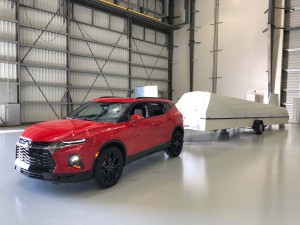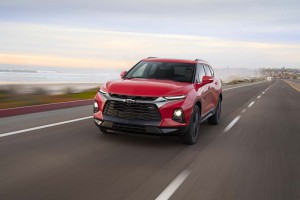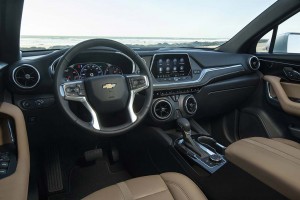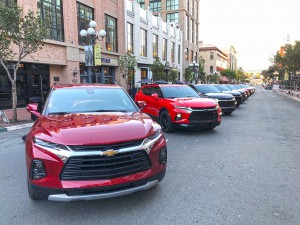Everything old is new again, it seems, with all sorts of once-forgotten nameplates rising from the dead. That includes the Chevrolet Blazer which will be rolling back into U.S. showrooms in the coming months.
For those who may remember the Blazer as a classically stocky, body-on-frame SUV, the arrival of the 2019 model could come as a big surprise, however. It’s now taking the form of a sleekly styled, car-based crossover that puts emphasis on the word “sport” and only marginally on the idea of off-roadability.
A couple days of driving the 2019 Chevrolet Blazer through San Diego and the surrounding countryside proved it to be one of the better new entries for those who will never see anything rougher than a gravel road. But the new ute will have to clear a few obstacles, nonetheless, as it has become the cause célèbre for those upset by Chevy parent General Motors’ decision to close three North American assembly plants this year.
Anyone who watched this weekend’s Super Bowl likely got a quick immersion into the controversy, GM’s Canadian union urging potential buyers not to purchase the new Blazer because it is being built at a factory in Mexico. It seems that politics, rather than vehicle attributes, could be the biggest influence for some potential Chevy Blazer buyers.
(For more on the union’s Super Bowl ad – and more on Super Bowl auto commercials, Click Here.)

While not intended for serious off-roading, the new Blazer can tow up to 4,500 pounds with an optional trailer package.
We won’t step into the controversy beyond saying that it would be too bad if it short-circuited Blazer’s return. The new truck is both visually appealing and, if you’re one of those who don’t intend to go rock-crawling, a lot of fun to drive.
One of the key factors for some interested shoppers will be the lack of a third-row seat, something that has become almost de rigueur in the midsize SUV segment. The trade-off is more room for those in Blazer’s two rows, increased cargo space and a decidedly sporty ride, especially for those who might opt for the sport-tuned Blazer RS. No, it’s not an SUV equivalent of a Camaro SS, but it does offer some performance-oriented features, including a sport-tuned suspension, that definitely enhance the ride.
But we’re getting ahead of ourselves. Let’s start by noting that the Chevy product team set out to produce three very distinct versions of the 2019 Blazer, starting with the base L model, the more lavishly equipped Premium, and the sporty RS. To their credit, the three models do have their own personalities, the Premium offering a surprisingly lavish amount of features, including the active cruise control that has been absent on some of the bowtie brand’s other recent entries.
Visually, the revived Blazer has essentially nothing in common with the boxy original. If anything, it almost seems to borrow from GM’s now-departed Pontiac brand, going for a noticeably wide-track stance. While it shares underlying architectures with a number of other current General Motors CUVs, Blazer’s track is 40 millimeters, or almost 1.6 inches, wider than that of the Cadillac XT5 – nearly as wide, in fact, as the bigger Chevy Traverse.

GM's Canadian union ran a spot during the Super Bowl focused on the upcoming plant cuts and the production of the Blazer in Mexico.
The result is that the new ute has a solid and planted appearance, further enhanced by flared fenders, front and back, as well as the dramatic grille that is framed by slit headlamps. Blazer eschews slab-siding from fenders and doors that give it a more creased and sculpted, almost coke-bottle look. The big wheel wells offer space enough for up to 21-inch wheels and tires.
(GM isn’t the only automaker reviving an old nameplate. Click Here for a review of the reborn Ford Ranger.)
Blazer’s floating roofline borders on cliché in the current market, but it isn’t quite as cartoonish as some competing crossovers. There’s a subtle curve to the roof, meanwhile, but it doesn’t drop quite so dramatically as to impinge on back row headroom. Indeed, passenger space is as roomy as anything in its class, though the extra legroom for rear occupants does mean a little less cargo space, especially with the seats up.
The cabin is reasonably refined in even the Blazer L trim. It’s when you opt for the Premium package that you’ll likely be in for a surprise. Chevy has been pushing its utility vehicles a bit up-market, as we saw with the launch of the Traverse High Country last year. Though the Blazer Premium doesn’t go quite as far, it’s still a big step up, with more refined, soft-touch materials and plenty of features – both standard and optional – you’d normally expect only on one of GM’s more up-market brands.
That includes 6 USB type A and C ports on the Premium, rear seats that both tilt and slide, under-floor storage in the cargo bay, an electrically operated glovebox that can be locked with a digital code and high-power wireless smartphone charging. Among the options, there’s a 120-volt outlet, a birdseye view camera mode, a rear camera mirror and a power tailgate that projects a bowtie where you can waggle your foot under the rear bumper to get it to automatically open up.
The Blazer’s overall sportiness is enhanced by the borrowing of some cues from the Camaro, most notably the big, round air vents which, on the RS, are red accented, as are other interior details.
We had the chance to drive all three versions of the 2019 Chevrolet Blazer during our trip to San Diego and that included time with both engine options. The base package is a front-drive offering with a 2.5-liter inline-four making 193 horsepower. It might satisfy some buyers but we expect most will opt up to the 3.6-liter V-6 that comes standard on the Premier and RS models. It bumps the numbers up to 308 hp and 270 lb-ft of torque. And that’ll help you hit 60 in 6.5 seconds in the front-drive configurations and a few tenths slower with all-wheel-drive, according to Chevy.
The Blazer, it turns out, is available with two different all-wheel-drive systems. On the base L it’s a single-clutch design with an open differential and can be switched to front-drive by the driver to save an estimated half to one mpg.
The more advanced system on the Premier and RS models uses a twin-clutch design and an electronically controlled limited-slip differential that adds torque-vectoring capabilities. To our surprise, it also was driver selectable but did not offer an automatic mode that could sense and respond to increasingly slippery road conditions. Meanwhile, the drive modes notably include sport and tow/haul, but no off-road options, unlike some midsize competitors.
Does that matter? Probably not. The reality is that few utility vehicle owners ever go beyond gravel and the occasional dirt road, but we’re still surprised Chevy has effectively written off anyone else by declining to add options like skid plates or any off-road modes, in contrast to products like the new Honda Passport.
That said, the bow-tie brand is clearly focusing on those who want to get the sportiness they once could opt for in a sedan in a new CUV. We’re clearly seeing a push in that direction, Ford adding new ST versions of both the Edge and Explorer.
The Blazer RS is a sort of tweener package. It doesn’t get any additional boost in performance but it does deliver more aggressive ride dynamics thanks to sport-tuned dampers, higher rate springs, larger stability bars and other enhancements that include a faster, 15.1:1 electronic power steering ratio. Some of the enhancements are quite ingenious, like the cross-axis ball joints that offer significantly more stiffness laterally than conventional rubber bushings. Yet that approach does not result in a notably harsher ride.
Driving through the tight mountain roads east of San Diego proved to be an unexpected thrill as we compared the Premier and RS editions. The more luxurious-focused edition wasn’t a wallower, but there was clearly more body roll going through the twisties. The RS offered just enough movement to give you a clear sense of what it was doing. No, it’s not a true replacement for the Camaro, but if a utility vehicle is what you’re set on, it’s a lot more fun to drive than most of the other models in its competitive set when you’re carving through corners.
As Chevy gets set to deliver the 2019 Blazer to showrooms it does face some potential challenges. First, there’s the lack of a third row that will clearly eliminate some potential buyers. Then there’s the decision to make this a true soft-roader. We’ll be curious to see how that decision stands when Ford brings back its own classic nameplate, the Bronco, later this year, as it is expected to retain more of its original, go-anywhere capabilities.
Then there’s the issue of price. A stripped down 2019 Chevrolet Blazer L with cloth seats and not much else will start at $35,690, a slightly more well-contented model with leather seats and the V-6 bumping that up to just under $40,000. The RS, meanwhile, starts at $41,790, and the Premier nudging all the way up to $46,795. That’s getting into Cadillac territory, a base XT5 starting at $41,695.
There’s one other obstacle and that’s the political issue that doesn’t seem to be going away. There are some folks who will simply ignore the Blazer because of where it’s being assembled. In today’s hyper-heated environment it’s difficult to argue for or against that. But it’s too bad that the Blazer could drop off the shopping list for some potential buyers. It’s a surprisingly good way to return the nameplate to production. Yes, a bit more expensive than we might have expected but from a value standpoint it delivers.
(GM CEO Barra sticks to her guns over U.S., Canadian plant closings. Click Here for more.)




